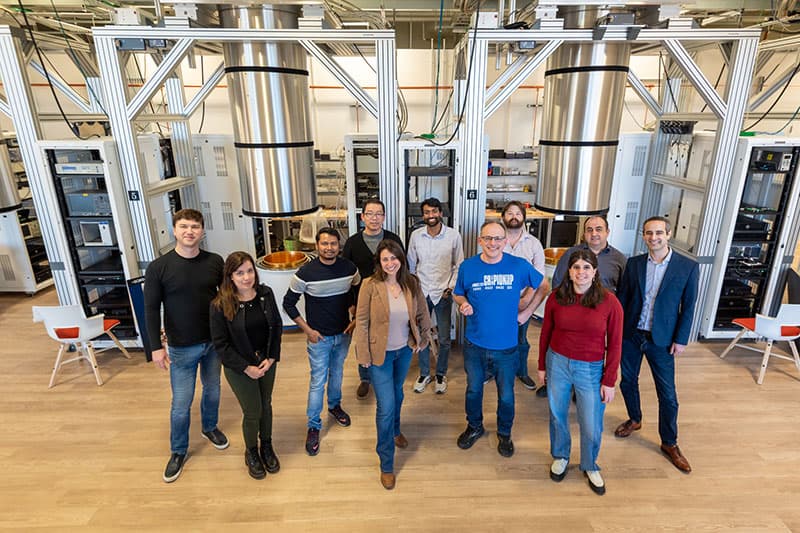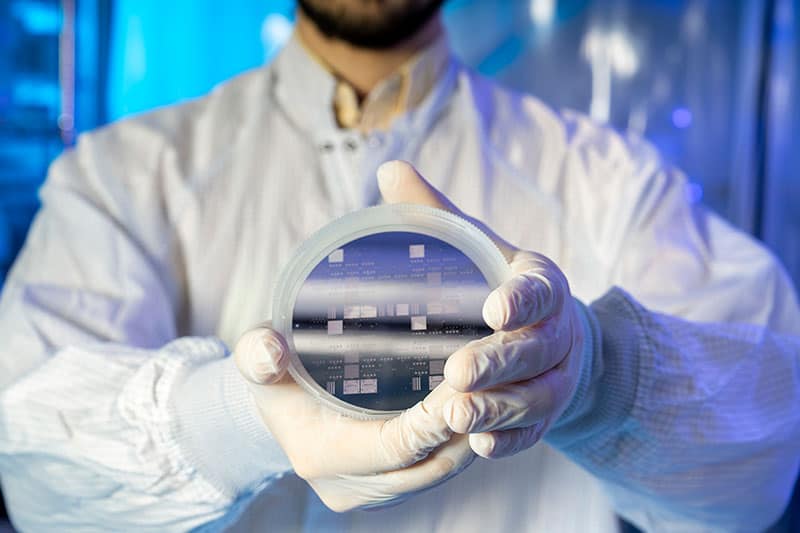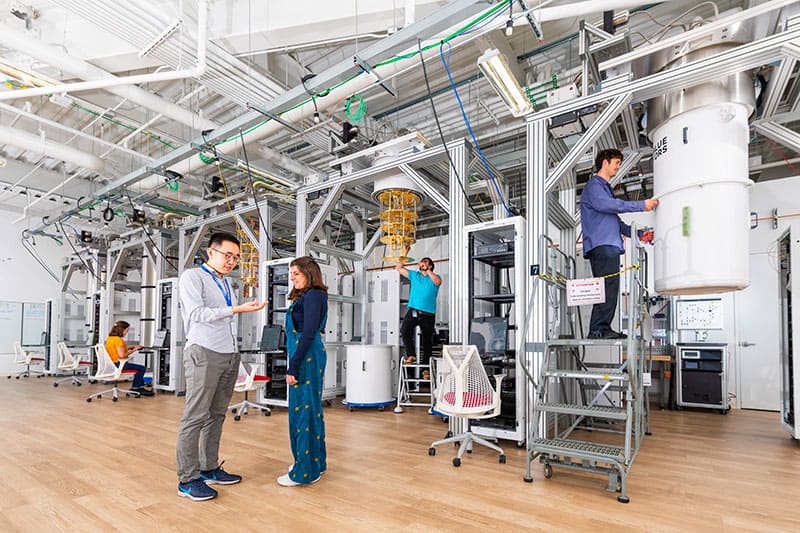The Superconducting Quantum Materials and Systems (SQMS) Center, led by Fermi National Accelerator Laboratory (Chicago, Illinois), is on a mission “to develop beyond-the-state-of-the-art quantum computers and sensors applying technologies developed for the world’s most advanced particle accelerators”. SQMS director Anna Grassellino talks to Physics World about the evolution of a unique multidisciplinary research hub for quantum science, technology and applications.
What’s the headline take on SQMS?
Established as part of the US National Quantum Initiative (NQI) Act of 2018, SQMS is one of the five National Quantum Information Science Research Centers run by the US Department of Energy (DOE). With funding of $115m through its initial five-year funding cycle (2020-25), SQMS represents a coordinated, at-scale effort – comprising 35 partner institutions – to address pressing scientific and technological challenges for the realization of practical quantum computers and sensors, as well as exploring how novel quantum tools can advance fundamental physics.
Our mission is to tackle one of the biggest cross-cutting challenges in quantum information science: the lifetime of superconducting quantum states – also known as the coherence time (the length of time that a qubit can effectively store and process information). Understanding and mitigating the physical processes that cause decoherence – and, by extension, limit the performance of superconducting qubits – is critical to the realization of practical and useful quantum computers and quantum sensors.
How is the centre delivering versus the vision laid out in the NQI?
SQMS has brought together an outstanding group of researchers who, collectively, have utilized a suite of enabling technologies from Fermilab’s accelerator science programme – and from our network of partners – to realize breakthroughs in qubit chip materials and fabrication processes; design and development of novel quantum devices and architectures; as well as the scale-up of complex quantum systems. Central to this endeavour are superconducting materials, superconducting radiofrequency (SRF) cavities and cryogenic systems – all workhorse technologies for particle accelerators employed in high-energy physics, nuclear physics and materials science.

Take our research on decoherence channels in quantum devices. SQMS has made significant progress in the fundamental science and mitigation of losses in the oxides, interfaces, substrates and metals that underpin high-coherence qubits and quantum processors. These advances – the result of wide-ranging experimental and theoretical investigations by SQMS materials scientists and engineers – led, for example, to the demonstration of transmon qubits (a type of charge qubit exhibiting reduced sensitivity to noise) with systematic improvements in coherence, record-breaking lifetimes of over a millisecond, and reductions in performance variation.
How are you building on these breakthroughs?
First of all, we have worked on technology transfer. By developing novel chip fabrication processes together with quantum computing companies, we have contributed to our industry partners’ results of up to 2.5x improvement in error performance in their superconducting chip-based quantum processors.
We have combined these qubit advances with Fermilab’s ultrahigh-coherence 3D SRF cavities: advancing our efforts to build a cavity-based quantum processor and, in turn, demonstrating the longest-lived superconducting multimode quantum processor unit ever built (coherence times in excess of 20 ms). These systems open the path to a more powerful qudit-based quantum computing approach. (A qudit is a multilevel quantum unit that can be more than two states.) What’s more, SQMS has already put these novel systems to use as quantum sensors within Fermilab’s particle physics programme – probing for the existence of dark-matter candidates, for example, as well as enabling precision measurements and fundamental tests of quantum mechanics.
Elsewhere, we have been pushing early-stage societal impacts of quantum technologies and applications – including the use of quantum computing methods to enhance data analysis in magnetic resonance imaging (MRI). Here, SQMS scientists are working alongside clinical experts at New York University Langone Health to apply quantum techniques to quantitative MRI, an emerging diagnostic modality that could one day provide doctors with a powerful tool for evaluating tissue damage and disease.
What technologies pursued by SQMS will be critical to the scale-up of quantum systems?
There are several important examples, but I will highlight two of specific note. For starters, there’s our R&D effort to efficiently scale millikelvin-regime cryogenic systems. SQMS teams are currently developing technologies for larger and higher-cooling-power dilution refrigerators. We have designed and prototyped novel systems allowing over 20x higher cooling power, a necessary step to enable the scale-up to thousands of superconducting qubits per dilution refrigerator.

Also, we are working to optimize microwave interconnects with very low energy loss, taking advantage of SQMS expertise in low-loss superconducting resonators and materials in the quantum regime. (Quantum interconnects are critical components for linking devices together to enable scaling to large quantum processors and systems.)
How important are partnerships to the SQMS mission?
Partnerships are foundational to the success of SQMS. The DOE National Quantum Information Science Research Centers were conceived and built as mini-Manhattan projects, bringing together the power of multidisciplinary and multi-institutional groups of experts. SQMS is a leading example of building bridges across the “quantum ecosystem” – with other national and federal laboratories, with academia and industry, and across agency and international boundaries.
In this way, we have scaled up unique capabilities – multidisciplinary know-how, infrastructure and a network of R&D collaborations – to tackle the decoherence challenge and to harvest the power of quantum technologies. A case study in this regard is Ames National Laboratory, a specialist DOE centre for materials science and engineering on the campus of Iowa State University.
Ames is a key player in a coalition of materials science experts – coordinated by SQMS – seeking to unlock fundamental insights about qubit decoherence at the nanoscale. Through Ames, SQMS and its partners get access to powerful analytical tools – modalities like terahertz spectroscopy and cryo transmission electron microscopy – that aren’t routinely found in academia or industry.
How extensive is the SQMS partner network?
All told, SQMS quantum platforms and experiments involve the collective efforts of more than 500 experts from 35 partner organizations, among them the National Institute for Standards and Technology (NIST), NASA Ames Research Center and Northwestern University; also leading companies in the quantum tech industry like IBM and Rigetti Computing. Our network extends internationally and includes flagship tie-ins with the UK’s National Physical Laboratory (NPL), the Institute for Nuclear Physics (INFN) in Italy, and the Institute for Quantum Computing (University of Waterloo, Canada).
What are the drivers for your engagement with the quantum technology industry?
The SQMS strategy for industry engagement is clear: to work hand-in-hand to solve technological challenges utilizing complementary facilities and expertise; to abate critical performance barriers; and to bring bidirectional value. I believe that even large companies do not have the ability to achieve practical quantum computing systems working exclusively on their own. The challenges at hand are vast and often require R&D partnerships among experts across diverse and highly specialized disciplines.
I also believe that DOE National Laboratories – given their depth of expertise and ability to build large-scale and complex scientific instruments – are, and will continue to be, key players in the development and deployment of the first useful and practical quantum computers. This means not only as end-users, but as technology developers. Our vision at SQMS is to lay the foundations of how we are going to build these extraordinary machines in partnership with industry. It’s about learning to work together and leveraging our mutual strengths.
How do Rigetti and IBM, for example, benefit from their engagement with SQMS?
Our collaboration with Rigetti Computing, a Silicon Valley company that’s building quantum computers, has been exemplary throughout: a two-way partnership that leverages the unique enabling technologies within SQMS to boost the performance of Rigetti’s superconducting quantum processors.
The partnership with IBM, although more recent, is equally significant. Together with IBM researchers, we are interested in developing quantum interconnects – including the development of high-Q cables to make them less lossy – for the high-fidelity connection and scale-up of quantum processors into large and useful quantum computing systems.
At the same time, SQMS scientists are exploring simulations of problems in high-energy physics and condensed-matter physics using quantum computing cloud services from Rigetti and IBM.
Presumably, similar benefits accrue to suppliers of ancillary equipment to the SQMS quantum R&D programme?
Correct. We challenge our suppliers of advanced materials and fabrication equipment to go above and beyond, working closely with them on continuous improvement and new product innovation. In this way, for example, our suppliers of silicon and sapphire substrates and nanofabrication platforms – key technologies for advanced quantum circuits – benefit from SQMS materials characterization tools and fundamental physics insights that would simply not be available in isolation. These technologies are still at a stage where we need fundamental science to help define the ideal materials specifications and standards.
We are also working with companies developing quantum control boards and software, collaborating on custom solutions to unique hardware architectures such as the cavity-based qudit platforms in development at Fermilab.
How is your team building capacity to support quantum R&D and technology innovation?
We’ve pursued a twin-track approach to the scaling of SQMS infrastructure. On the one hand, we have augmented – very successfully – a network of pre-existing facilities at Fermilab and at SQMS partners, spanning accelerator technologies, materials science and cryogenic engineering. In aggregate, this covers hundreds of millions of dollars’ worth of infrastructure that we have re-employed or upgraded for studying quantum devices, including access to a host of leading-edge facilities via our R&D partners – for example, microkelvin-regime quantum platforms at Royal Holloway, University of London, and underground quantum testbeds at INFN’s Gran Sasso Laboratory.

In parallel, we have invested in new and dedicated infrastructure to accelerate our quantum R&D programme. The Quantum Garage here at Fermilab is the centrepiece of this effort: a 560 square-metre laboratory with a fleet of six additional dilution refrigerators for cryogenic cooling of SQMS experiments as well as test, measurement and characterization of superconducting qubits, quantum processors, high-coherence quantum sensors and quantum interconnects.
What is the vision for the future of SQMS?
SQMS is putting together an exciting proposal in response to a DOE call for the next five years of research. Our efforts on coherence will remain paramount. We have come a long way, but the field still needs to make substantial advances in terms of noise reduction of superconducting quantum devices. There’s great momentum and we will continue to build on the discoveries made so far.
We have also demonstrated significant progress regarding our 3D SRF cavity-based quantum computing platform. So much so that we now have a clear vision of how to implement a mid-scale prototype quantum computer with over 50 qudits in the coming years. To get us there, we will be laying out an exciting SQMS quantum computing roadmap by the end of 2025.
It’s equally imperative to address the scalability of quantum systems. Together with industry, we will work to demonstrate practical and economically feasible approaches to be able to scale up to large quantum computing data centres with millions of qubits.
Finally, SQMS scientists will work on exploring early-stage applications of quantum computers, sensors and networks. Technology will drive the science, science will push the technology – a continuous virtuous cycle that I’m certain will lead to plenty more ground-breaking discoveries.
How SQMS is bridging the quantum skills gap

As with its efforts in infrastructure and capacity-building, SQMS is addressing quantum workforce development on multiple fronts.
Across the centre, Grassellino and her management team have recruited upwards of 150 technical staff and early-career researchers over the past five years to accelerate the SQMS R&D effort. “These ‘boots on the ground’ are a mix of PhD students, postdoctoral researchers plus senior research and engineering managers,” she explains.
Another significant initiative was launched in summer 2023, when SQMS hosted nearly 150 delegates at Fermilab for the inaugural US Quantum Information Science (USQIS) School – now an annual event organized in conjunction with other National Laboratories, academia and industry. The long-term goal is to develop the next generation of quantum scientists, engineers and technicians by sharing SQMS know-how and experimental skills in a systematic way.
“The prioritization of quantum education and training is key to sustainable workforce development,” notes Grassellino. With this in mind, she is currently in talks with academic and industry partners about an SQMS-developed master’s degree in quantum engineering. Such a programme would reinforce the centre’s already diverse internship initiatives, with graduate students benefiting from dedicated placements at SQMS and its network partners.
“Wherever possible, we aim to assign our interns with co-supervisors – one from a National Laboratory, say, another from industry,” adds Grassellino. “This ensures the learning experience shapes informed decision-making about future career pathways in quantum science and technology.”
The post Fermilab’s Anna Grassellino: eyeing the prize of quantum advantage appeared first on Physics World.

